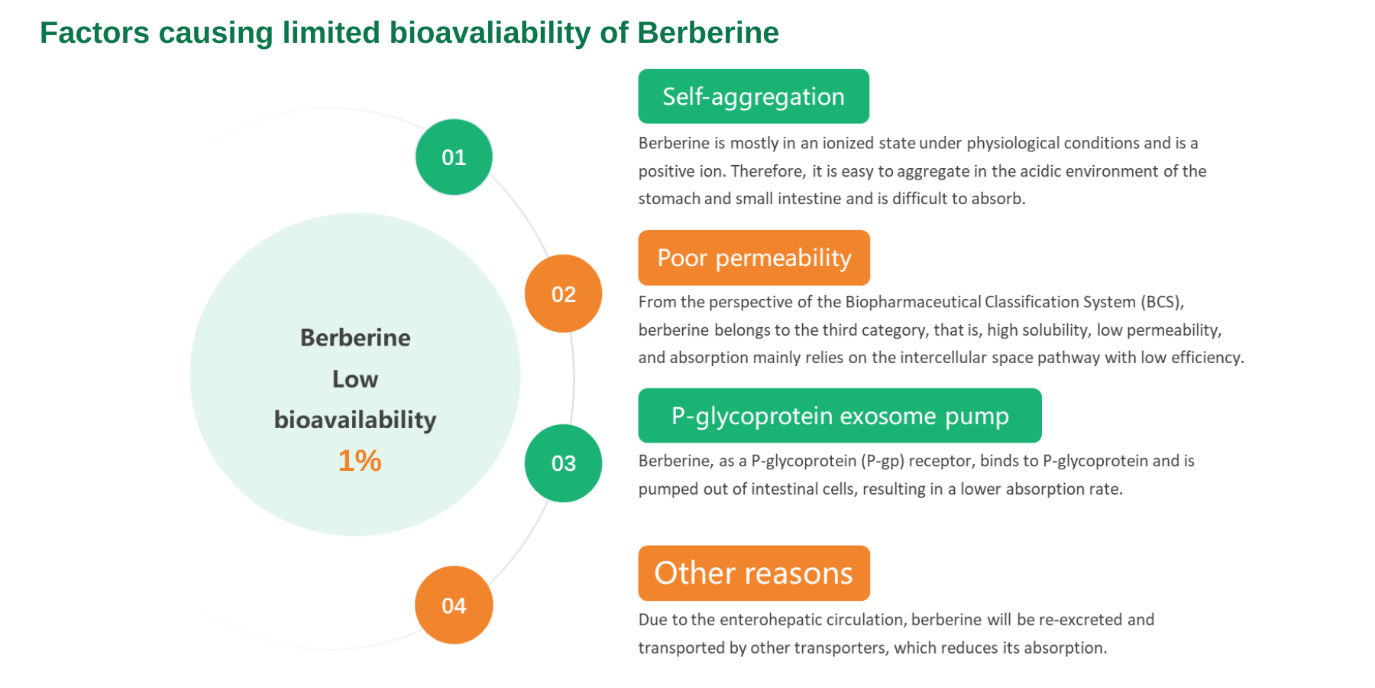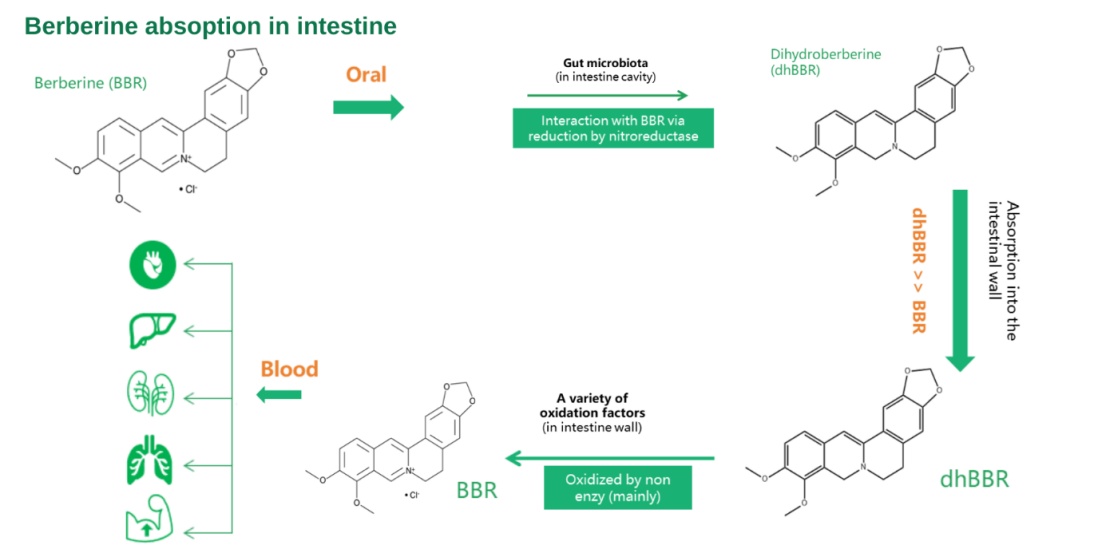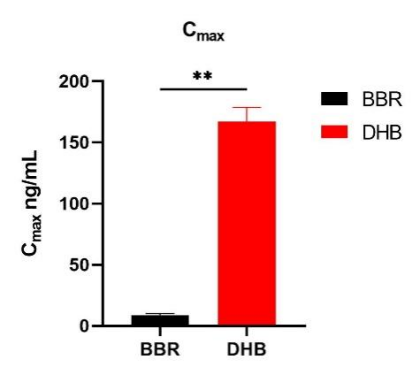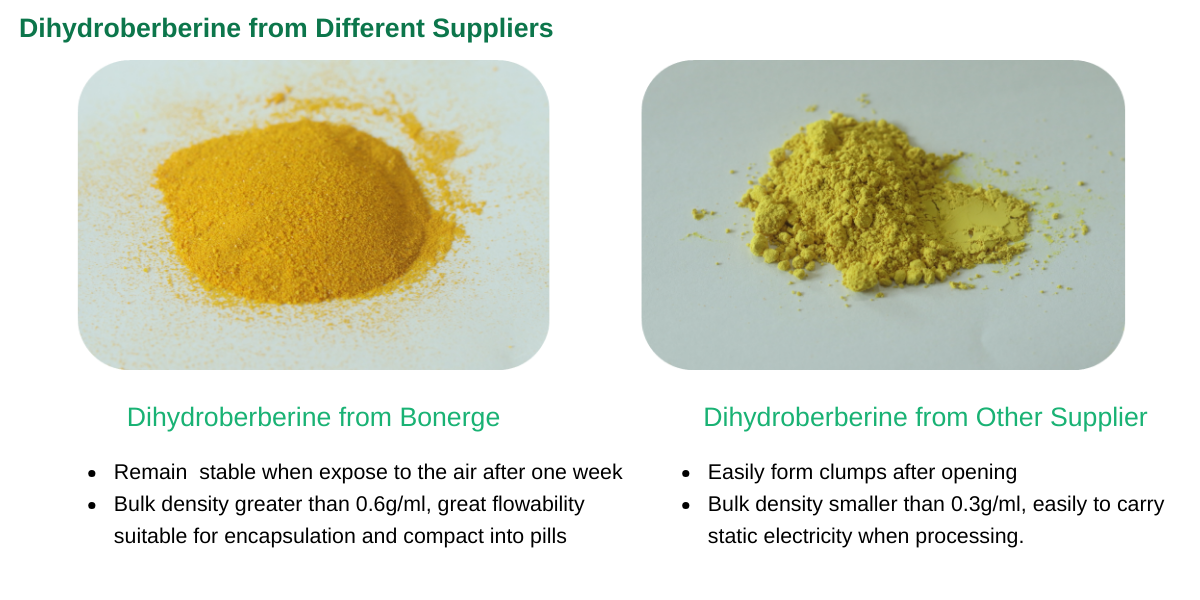Dihydroberberine,A bioavailable form of Berberine for enhanced health outcomes and efficiencies in production
With the evolution of the food industry and modern lifestyle changes, health issues such as obesity, diabetes, and cardiovascular disease have become significant threats to health and wellbeing.
These health issues might be caused by metabolic disorders or metabolic syndrome.1 Therefore, keeping a healthy metabolic function is the key to health management.
These issues not only impact individual health and quality of life but also place a substantial burden on society and the healthcare system. In response, brands have introduced various products to address weight loss and blood glucose control needs. Berberine has gained popularity for its multiple health benefits, including insulin sensitivity and lipid regulation capabilities.
Since 2022, Berberine has gone viral on TikTok in the US, catalyzed by a user sharing her successful weight loss journey with the supplement. These short videos garnered widespread attention, and the internet quickly dubbed Berberine ‘Nature’s Ozempic’ or ‘Natural GLP-1 agonist’ .
Experiences related to weight loss using Berberine amassed billions of views, leading to a dramatic surge in demand. Many Berberine products sold out, even causing a shortage of raw materials.
Berberine: The natural glucagon-like peptide-1(GLP-1) stimulator
Berberine, primarily derived from plants with a long history of use, was first recorded in ancient Chinese medical ‘Shen-Nong's Herbal Classics’ over 3,000 years ago. Initially, Berberine was mainly used for its antibacterial, antiviral, and diarrheal relief properties.
In recent years, modern science has gradually uncovered various pharmacological effects of Berberine, leading to its widespread use in clinical practice. Research has found that Berberine exerts its health benefits through several mechanisms.
Key benefits of Berberine and related health benefits:
✅ Promotes GLP-1 secretion
Increases GLP-1 secretion by promoting the expression of glucagon mRNA and the proliferation of intestinal L-cells.2
Activates the bitter taste receptor TAS2R38 in the intestine, stimulating GLP-1 secretion from L-cells.2
✅ Regulates blood sugar metabolism and improves insulin resistance
Stimulates insulin receptor expression, enhances insulin sensitivity and improves insulin resistance.3
Upregulates glucose transporter type 4 (Glut4) expression, promoting glucose uptake by cells and reducing blood glucose levels.4
Reduces oxygen consumption and ATP production in mitochondria, and inhibits the expression of gluconeogenesis transcription factors (G6Pase and PEPCK), thereby lowering fasting blood sugar levels.5
✅ Increases brown fat content and improves fat metabolism
Promotes the expression of browning genes in white adipose tissue, increasing brown fat quantity and enhancing brown tissue function, leading to increased energy expenditure and thermogenesis.6
Inhibits the expression of transcription factors related to fat production (SREBPs and ChREBP) via the AMPKα pathway, reducing fat synthesis enzyme levels and improving fat metabolism.7,8
✅ Regulates cholesterol metabolism
Downregulates the expression of acyl-CoA cholesterol acyltransferase-2, reducing cholesterol uptake and cell monolayer permeability.9
Upregulates the gene expression of sterol 27-hydroxylase and cholesterol-7α-hydroxylase, inhibiting intestinal cholesterol absorption.10
Lowers levels of plasma LDL cholesterol, free fatty acids (FFAs), and total cholesterol via the AMPK pathway while increasing HDL cholesterol levels.11,12
✅ Reduces inflammation and oxidative stress damage
Exerts anti-inflammatory effects by inhibiting cyclooxygenase-2 expression through the suppression of AP-1 binding.13
Modulates oxidative stress markers and antioxidant enzyme levels through complex mechanisms like AMPK activation, NF-κB and AP-1 pathway inhibition, and Nrf2 pathway regulation, reducing pro-inflammatory cytokine levels.13
The limitations of Berberine in practical applications
Despite the huge enthusiasm for Berberine, scientific studies have found limitations in its application, such as low bioavailability, poor intestinal absorption, and potential irritations on the GI tract.14
Sub-chronic toxicity of Berberine indicates the potential damage of lung and liver in animal at very high dosage.15 This has motivated Bonerge to step forward to test the safety of Berberine and Dihydroberberine.

Figure 1: Reasons causing limited bioavailability of Berberine.16
Dihydroberberine: A more bioavailable form of Berberine
Dihydroberberine is a research-proven bioactive form of Berberine derivative. When Berberine is orally ingested, it is reduced to Dihydroberberine in the intestine, absorbed through the intestinal wall, and then converted back to Berberine in the blood to exert its effects. Thus, Dihydroberberine can be absorbed more rapidly by the intestinal wall, resulting in higher bioavailability compared to Berberine.17

Figure 2: Berberine absorption mechanism in intestine.17
Better absorption efficiency
To investigate the bioavailability advantage of GlucoSober Dihydroberberine over conventional Berberine, pharmacokinetic studies were conducted in mice.
Following oral administration of Dihydroberberine, plasma analysis revealed undetectable levels of Dihydroberberine, while Berberine concentration showed rapid elevation.
Pharmacokinetic evaluation based on Berberine's plasma concentration-time profile demonstrated that GlucoSober™ exhibits 54-fold higher oral bioavailability than Berberine.
Maximum Plasma Concentration (Cmax): GlucoSober Dihydroberberine achieved a maximum plasma concentration (Cmax)19.12 times greater than that observed in the Berberine group.

Better health benefits
Dihydroberberine has been scientifically shown to be more effective than Berberine in improving insulin sensitivity, reducing adiposity, and supporting cardiovascular health18,19. The stable, high-quality GlucoSober™ Dihydroberberine is a promising product that delivers the fuller range of health benefits associated with Dihydroberberine.
✅ Enhanced insulin sensitivity:In the high-fat diet (HFD) rat model, supplementation with 100 mg/kg/day Dihydroberberine had a better effect on metabolic health than 560 mg/kg/day Berberine. The insulin sensitivity increased by 44% in the Dihydroberberine group, while it increased by only 10% in the Berberine group[18].
✅ Reduced visceral fat: In mice fed an HFD(high fat diet), treatment with Dihydroberberine(100 mg/kg/day) markedly reduced adiposity (epididymal fat, muscle fat, liver fat) , compared with HFD controls. At the same dose, Berberine had no effect on adiposity. Dihydroberberine is of great help in reducing visceral fat18.
✅ Better atherosclerosis effect:Research shows that Dihydroberberine is better at inhibiting inflammation and reducing atherosclerotic plaque size and vulnerability. This indicates that Dihydroberberine reduces plaque area in mice arteries by 44.4%, while Berberine reduces it by 15.5%19.
✅ Better anti-colitis effect:Dihydroberberine treatment effectively alleviates ulcerative colitis by relieving clinical manifestation better than Berberine via a similar beneficial effect to azathioprine. 25 mg/kg Dihydroberberine was as effective as a 50 mg/kg dose of Berberine20.
Improved quality Dihydroberberine cuts handling troubles
Bonerge Lifescience has initiated the patent application process for GlucoSoberTM – a high-quality Dihydroberberine ingredient tailored to fulfill the escalating market demand for Berberine.
Relatively speaking, Dihydroberberine is a newcomer in the market, and the quality varies significantly among different suppliers. Owing to its high bioactivity and potent antioxidant properties, Dihydroberberine is susceptible to oxidative and light degradation.
Furthermore, similar to many powder ingredients, regular Dihydroberberine tends to agglomerate when exposed to moisture and generates static electricity during encapsulation. This leads to excessive production losses and poses challenges in cleaning equipment.
To overcome the issues of Dihydroberberine's light sensitivity and clumping, Bonerge has developed GlucoSober, accomplished through a patent-pending manufacturing process.
GlucoSober is more stable, possesses better fluidity, has fewer impurities, and both its purity and content exceed 98%. Additionally, there is a distinctive high-density granulation specification of GlucoSober (bulk density greater than 0.6 g/ml), which can enhance the processing efficiency for the production of tablets and capsules.

Figure 3: GlucoSober vs. Dihydroberberine from other supplier
Apart from developing high-quality product processes, Bonerge intends to conduct human clinical trials in the coming months to further assess the health value of Berberine and Dihydroberberine in blood glucose metabolism and weight management.
Bonerge will persist in investing in product research and evidence-based active ingredients, collaborating with global partners to select GlucoSober. Bonerge are motivated by the delight of witnessing consumers deriving health benefits from its ingredients, which inspires innovation.
References
[1] Mayo Clinic, Mayo Foundation for Medical Education and Research.
[2] Yu Y, Hao G, Zhang Q, et al. Biochem Pharmacol, 2015, 97(2): 173-7.
[3] Kong WJ, Zhang H, Song DQ, et al. Metabolism, 2009, 58(1): 109-19.
[4] Mi J, He W, Lv J, et al. Diabetes Metab Syndr Obes, 2019, 12: 1717-25.
[5] Xia X, Yan J, Shen Y, et al. PLoS One, 2011, 6(2): e16556.
[6] Zhang Z, Zhang H, Li B, et al. Nat Commun, 2014, 5: 5493.
[7] Ren G, Guo JH, Qian YZ, et al. Front Pharmacol, 2020, 11: 647.
[8] Zhu X, Bian H, Wang L, et al. Free Radic Biol Med, 2019, 141: 192-204.
[9] Wang Y, Yi X, Ghanam K, et al. Metabolism, 2014, 63(9): 1167-77.
[10] Kong W, Wei J, Abidi P, et al. Nat Med, 2004, 10(12): 1344-51.
[11] Kim WS, Lee YS, Cha SH, et al. Am J Physiol Endocrinol Metab, 2009, 296(4): E812-9.
[12] Jiang D, Wang D, Zhuang X, et al. Lipids Health Dis, 2016, 15(1).
[13] Zou K, Li Z, Zhang Y, et al. Acta Pharmacol Sin, 2017, 38(2): 157-67.
[14] U.S. National Library of Medicine.
[15] Ning N, Wang YZ, Zou ZY, et al. Environ Toxicol Pharmacol, 2015, 39(1): 53-69.
[16] Xu HY, Liu CS, Huang CL, et al. Colloids Surf B Biointerfaces, 2019, 181: 927-34.
[17] Feng R, Shou JW, Zhao ZX, et al. Sci Rep, 2015, 5(1).
[18] Turner N, Li JY, Gosby A, et al. Diabetes, 2008, 57(5): 1414-8.
[19] Chen J, Cao J, Fang L, et al. Atherosclerosis, 2014, 12: 1-13.
[20] Li C, Dong N, Wu B, et al. Phytomedicine, 2021, 90.
Disclaimer *
The information available on this site is solely for the purpose of providing general knowledge. All information, including any text, expression or statement, is intended for business-to-business customers only and not intended for end-use consumers.
News & Blog
Related Ingredients
Next Page








